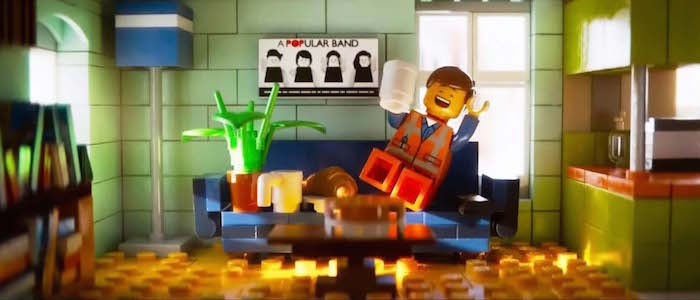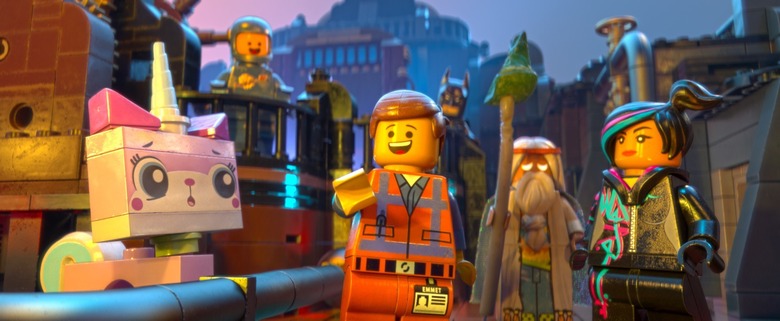How 'The LEGO Movie' Transformed A Bad Premise Into A Cinematic Miracle
Here's a blunt truth: The LEGO Movie should not work as a movie, let alone work as a great movie. On paper, even the premise of a movie based on a line of toys with no singular identity of its own, a line that explicitly develops playsets themed around licensed properties as an extension of managed brands, sounds like the most tedious sort of late-stage capitalist cynicism. It sounds like the sort of corporately-driven idea that is designed from the ground up to act as an advertisement to children that their parents must pay for them to see in the theater, normalizing the practice of brands selling themselves on name alone regardless of intrinsic value or quality of output.And, on one level, that's exactly what The LEGO Movie is. It absolutely is a product made for the express purpose of self-celebration, giving the LEGO brand a platform to proclaim its own cultural impact. But it's also a film that is surprisingly self-aware of that motivation and doesn't really try to hide it, instead leaning heavily into the ethos that if the film is good enough that the inherent anti-artistry of the premise ultimately doesn't matter.And it works! But why does it work? The answer lies in some very smart and well-informed decisions baked into The LEGO Movie's writing, and perhaps as importantly, in the subversive brilliance of its writers and directors.
Phil Lord and Christopher Miller: Master Builders
Writer-directors Phil Lord and Christopher Miller are, at this point, well known for their ability to turn bad ideas into successful films. Their first feature film together, Cloudy with a Chance of Meatballs, is a licensed adaptation of a children's picture book without much more plot than "Hey, food fell from the sky this one time, which sure was weird." In their hands, the story became a cautionary tale of institutional insecurity, framing the shallow idea of food-based weather by a lonely genius as an exploitable net positive until that exploitation ultimately turns the initial good of creativity into a self-destructive force. Their next film, 21 Jump Street, is a remake of a modestly popular late-80s television show mainly remembered as the place where Johnny Depp got his start, so they made the focus of the film a farcical examination of the show's central gimmick while mocking the very idea of putting that gimmick into action. Then that film's sequel, 22 Jump Street, is a deconstruction of redundant sequelizing, undermining the idea of giving people more of what they liked before but telling a story about characters learning not to fall into such creative ruts.All this is to say that Lord and Miller are not just reflexively metafictional about their adapted projects, but are actively aware of the thematic difficulties inherent in the projects they work on, opting to address those issues head-on by making their films about those difficulties rather than pretending they don't exist. This is why their potential version of Solo: A Star Wars Story feels like a lost opportunity to lampoon the nature of unnecessarily lore-driven prequels, or why Phil Lord's contributions to the screenplay for Spider-Man: Into The Spiderverse turn the nakedly transparent goal of creating Sony's answer to The Avengers into one of the most comic-inspired and character-driven superhero films ever made. Lord and Miller's specialty is taking bad ideas and making them work, and there perhaps isn't as clear an example as their work on The LEGO Movie.
Playing in the Toybox
So from what angle does one approach making a film so transparently about toys? Why, you start from a place of play! The most obvious evidence of this is in how the LEGO world is animated, replicating the stuttering non-fluidity of stop-motion animation that looks much like how a child would move these characters and environments around in their attempts to craft their own story. Furthermore, the entire world is built of LEGOs, save for the intrusion of some larger-than-life artifacts such as a Band-Aid or an X-Acto knife that LEGO people ascribe their own meaning to while those in the audience recognize them as real-world artifacts mixed in with the toys. Sound effects of dramatic moments are undercut by the burbling of a child approximating a vehicle's engine, and the ghost of the wizard Vitruvius floats on a literal dangling string. The world of The LEGO Movie is one of explicit playtime through the makeshift manifestations of whatever household goods are at hand, driven by a conflict of evil seemingly for its own sake but consistently reflective of the pathos of a child acting out a hero's journey.And it's from this sense of surreality that The LEGO Movie draws most of its humor. There are a lot of jokes at the expense of the tortured logic of the world-hopping plotting, with characters often stopping to jokingly question the internal consistency of their world, and there's a persistent self-awareness that these characters, particularly those based on licensed properties, have backstories completely divorced from their existence as LEGOs. Batman shows up because he's Batman and he's cool, and his character largely revolves around reminding himself just how cool he is, much as a child reasserts the awesomeness of their heroes through playacting. This is how Lord and Miller get around the inherent problem of their blatantly commercial premise: they build a story around the conceit of childlike play that isn't beholden to things like continuity or logical characterizations, allowing characters like Superman and Gandalf and Dumbledore to exist in the same room because that's the sort of awesome nonsensical crossover a child would conceive to face down the ultimate bad guy.
The Importance of Being The Special
This sort of metatextual understanding of the appeal of LEGOs would be clever on its own, but what elevates The LEGO Movie into a modern masterpiece is how it expresses its themes in literal terms. The running insecurity of Emmet's character throughout the film is this idea that he is supposed to be The Special, a Master Builder with the power to topple the strict, perfection-obsessed rule of President Business, voiced by Will Ferrell. However, Emmet himself is bound by a sense of loyalty to instruction and routine, so much so that even those in his old life as a construction worker don't see him as anything more than a blank slate. It's only through an exploration of play and creativity that he is able to unlock his potential as a Builder, though it's his understanding of planning and accepted norms that allow the Master Builders to infiltrate President Business's skyscraper lair.But then Emmet hits an emotional low upon the realization that the prophecy of The Special was entirely made up, and that Emmet's importance is not preordained by anything other than clumsiness and circumstance. It's in this moment that Emmet commits an act of suicidal self-sacrifice, falling out of his world and into... ours. This entire exercise of playful imagining and absurdist self-awareness of a world constructed of reconstitutable bricks has always been just as it appeared: the playful imaginings of an eight-and-a-half-year-old boy. And that playtime is interrupted by the intrusion of the mythical Man Upstairs, the boy's father, played also by none other than Will Farrell.It's with that expert bit of casting and a look around the extensive modelling of the playroom that all the pieces fall into place. This child has been playing with his father's LEGOs, which his father collects and builds with the exactness of the instructions in the box, treating these playthings as art installations by sticking the pieces together with Krazy Glue. This is in turn a reflection of how the child conceptualizes President Business, whose evil scheme is to freeze all the realms of LEGO with his own glue-like superweapon. What at first appeared to be an innocent and light-hearted romp through a fantastical world of colorful bricks is revealed to be a child's reenactment of his own insecurities, externalizing his inability to understand his father's obsession with toys that are not to be played with into a story where the protagonist wonders why he isn't special enough to play at all.When Emmet goes back to his LEGO world and finally confronts President Business, the film crosscuts with the human Will Ferrell, not as a moment of action or conflict, but as a conversation. In the LEGO city, resistance against President Business' army of micromanagers has manifested into everyday citizens rising up and building their own creative weapons and vehicles to fight back. As Emmet points out, the prophecy of The Special might be made up, but it's also true because everyone has the ability to be special, to make something unique with the tools at their disposal and the depths of their imagination. As the father recognizes how his obsession has negatively impacted his child, the chaotic beauty of a world where anything can be built is restored, building upon the foundations of the instruction manual rather than being constrained by it. Emmet's understanding of both foundational form and chaotic creation is what acts as a bridged gap between the father's and son's conceptions of how toys are meant to be played with.This transformation of the premise's weakness into its greatest strength is the genius of The LEGO Movie. A lesser version of this film would be a straightforward take on the idea of LEGO people living in a LEGO world, telling a generic story of self-acceptance and empowerment with LEGOs acting as an aesthetic flourish rather than an integral part of the narrative. But Lord and Miller aren't content to simply make a feature length commercial, instead diving deep into why LEGOs are important, why toys are important, why play is important. One could still look to The LEGO Movie and see it as testament to brand integration and corporate synergy, but to do so would be a denial of the understanding these filmmakers have of why anyone would want to see a movie based on a toy in the first place.


